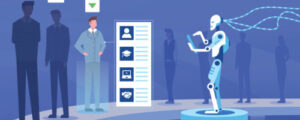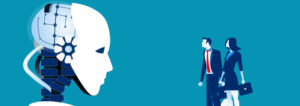Managing the shift to a hybrid human-AI workforce
- 5 Min Read
New research has highlighted the importance of business leaders preparing for the future of automation. However there are many challenges that come along with adapting to these technological changes.
- Author: Louron Pratt
- Date published: Mar 21, 2019
- Categories

Many companies have anticipated huge advancements in Artificial intelligence in the coming years with reports suggesting that 67% of business leaders worry that this could have a negative impact on their business if they fail to adapt to this hybrid workforce.
Capita People Solutions found that 72% of business leaders see the ‘human-to-hybrid’ transition as their top priority. Additionally, 93% acknowledge that they need to start managing this shift this year.
 Erika Bannerman, Executive Officer at Capita People Solutions, said “The shape and make-up of workforces across all industries will change dramatically over the next few years and business leaders have to get on the front foot to manage this transition. Investing in AI and automation is not enough to build a sustainable or productive hybrid workforce; organisations also need to ensure they have the skills, cultures and processes in place to work alongside this technology.”
Erika Bannerman, Executive Officer at Capita People Solutions, said “The shape and make-up of workforces across all industries will change dramatically over the next few years and business leaders have to get on the front foot to manage this transition. Investing in AI and automation is not enough to build a sustainable or productive hybrid workforce; organisations also need to ensure they have the skills, cultures and processes in place to work alongside this technology.”
Erika went on to discuss what it’s important for organisations and HR leaders alike to address in this radical change “It has to be a people-first approach, where innovative technology is used to support, enable and empower a highly-skilled, motivated and agile human workforce to deliver higher value work. That means business and HR leaders listening to their employees and engaging in a meaningful dialogue around these future workforce dynamics, being open and transparent about their vision and plans, and motivating and engaging their people to thrive in this future world of work.”
In addition to organisations worrying about these technological advances being made. This is only one of their many worries, as challenges for business leaders include overcoming employee resistance and feat of these changes, re-skilling people within their existing workforce, and dealing with a lack of knowledge in these new technologies.
Although many organisations intend to rise to the challenge of automation a report by the Institute for Women’s Policy Research found that this could significantly impact women in work. In their report they found that “while men outnumber women in the workforce, women outnumber men among workers both in occupations with the highest risk of automation and in those with the lowest risk. Women make up just under half (47%) of the workforce, but they are 58% of workers at the highest risk of automation, and 52% of workers in the lowest risk occupations”
They then went on to discuss that these occupations under risk could have a huge wide-spread effect on women “ the occupations most at risk of automation for men are also the occupations with the lowest earnings. For women, such risk is more equally spread across better- and low-paid occupations. Thus, women potentially face a higher economic risk from automation because technological change is more likely to replace middle and well-paid jobs in their top 20 than it is for men”
So although the rise in automation could unlock a number of opportunities for organisations to succeed, it’s important for business leaders to also address these challenges if they are to attract and retain the best talent. With these challenges at hand HR leaders have an important role to face in ensuring that they are maintaining the positive culture of their workforce despite these constant changes to automation and a hybrid workforce.
Erika concluded by saying “Business and HR leaders are facing some important questions around the impact that a hybrid workforce will have on workplace culture and collaboration, recognition and rewards, and diversity and inclusion. The organisations that will thrive in the future will be those that can identify, recruit and retain the skills they need to compete, and develop learning cultures which ensure they have the agility and speed to adapt to changing market conditions and opportunities. This can only be achieved with the right learning cultures and an unrelenting focus on delivering a first-rate employee experience throughout the organisation.”
With these changes being made, it’s also imperative for business leaders to prepare their employees for these changes, by equipping them with the right skills to thrive in this ever-changing world of work. However studies by PwC showcased that there is still a lot improve on in this specific area, as 41% of participants of this report said that their employers haven’t made any progress in equipping their staff for these arising changes.
Alastair Woods, partner at PwC, commented on these findings, saying “HR departments must lead the way in growing and building the capabilities the workforce of tomorrow will require. The impact of automation and robotics over the course of the next decade will mean some tasks disappear, but new activities will emerge that rely on uniquely human skills like judgement, empathy, innovation. To prepare for this change HR teams must develop a thorough understanding of future needs and put in place the learning and development programmes and other tools like performance management to help and underpin this transition.”
With this introduction of A.I. increasingly having an influence on the future workforce, business leaders may struggle to shift to this new age. However if they do adapt well, this could be the key to succeeding in the new world of work.









